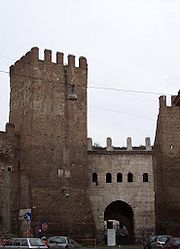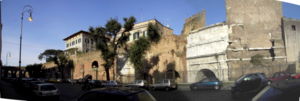
Porta Tiburtina
Encyclopedia

Aurelian Walls
The Aurelian Walls is a line of city walls built between 271 and 275 in Rome, Italy, during the reign of the Roman Emperors Aurelian and Probus....
of Rome
Rome
Rome is the capital of Italy and the country's largest and most populated city and comune, with over 2.7 million residents in . The city is located in the central-western portion of the Italian Peninsula, on the Tiber River within the Lazio region of Italy.Rome's history spans two and a half...
, Italy
Italy
Italy , officially the Italian Republic languages]] under the European Charter for Regional or Minority Languages. In each of these, Italy's official name is as follows:;;;;;;;;), is a unitary parliamentary republic in South-Central Europe. To the north it borders France, Switzerland, Austria and...
, through which the Via Tiburtina
Via Tiburtina
Via Tiburtina is an ancient road in Italy leading east-northeast from Rome to Tivoli . It was built by the Roman consul Marcus Valerius Maximus around 286 BC and later lengthened to the territories of the Marsi and the Equi, in the Abruzzo, as Via Valeria. Its total length was approximately...
exits the city.
History
The gate originally was an arch, built under AugustusAugustus
Augustus ;23 September 63 BC – 19 August AD 14) is considered the first emperor of the Roman Empire, which he ruled alone from 27 BC until his death in 14 AD.The dates of his rule are contemporary dates; Augustus lived under two calendars, the Roman Republican until 45 BC, and the Julian...
, in the point in which three aqueducts (Aqua Marcia
Aqua Marcia
The Aqua Marcia was the longest of the 11 aqueducts that supplied the city of ancient Rome. The still-functioning Acqua Felice from 1586 runs on long stretches along the route of the Aqua Marcia....
, Aqua Julia
Aqua Julia
The Aqua Julia or Aqua Iulia is a Roman aqueduct built in 33 BC by Agrippa. It was repaired and expanded by Augustus from 11–4 BC....
and Aqua Tepula
Aqua Tepula
The Aqua Tepula is an ancient Roman aqueduct built in 126 BC by censors G. Servilius Caepio and L. Cassius Longinus. Its source was at the Alban hills, running only a mere 18 kilometers to Rome...
) passed over the Via Tiburtina. The arch was restored by Emperors Titus
Titus
Titus , was Roman Emperor from 79 to 81. A member of the Flavian dynasty, Titus succeeded his father Vespasian upon his death, thus becoming the first Roman Emperor to come to the throne after his own father....
and Caracalla
Caracalla
Caracalla , was Roman emperor from 198 to 217. The eldest son of Septimius Severus, he ruled jointly with his younger brother Geta until he murdered the latter in 211...
.
The arch of Augustus was incorporated in the Aurelian Walls
Aurelian Walls
The Aurelian Walls is a line of city walls built between 271 and 275 in Rome, Italy, during the reign of the Roman Emperors Aurelian and Probus....
by Emperor Aurelian
Aurelian
Aurelian , was Roman Emperor from 270 to 275. During his reign, he defeated the Alamanni after a devastating war. He also defeated the Goths, Vandals, Juthungi, Sarmatians, and Carpi. Aurelian restored the Empire's eastern provinces after his conquest of the Palmyrene Empire in 273. The following...
. At the time of Honorius
Honorius (emperor)
Honorius , was Western Roman Emperor from 395 to 423. He was the younger son of emperor Theodosius I and his first wife Aelia Flaccilla, and brother of the eastern emperor Arcadius....
' restoration, in the 5th century, a second, external opening was built, with five small openings that enlightened the room where the gate was operated.
With time, the gate changed its name into Porta San Lorenzo, because of the presence of the close by basilica
Basilica
The Latin word basilica , was originally used to describe a Roman public building, usually located in the forum of a Roman town. Public basilicas began to appear in Hellenistic cities in the 2nd century BC.The term was also applied to buildings used for religious purposes...
of San Lorenzo fuori le Mura
San Lorenzo fuori le Mura
The Papal Basilica of Saint Lawrence outside the Walls is a Roman Catholic parish church and minor basilica, located in Rome, Italy. The basilica is one of the Seven Pilgrim Churches of Rome and one of the five Patriarchal basilicas, each of which is assigned to a patriarchate. St...
. Common people, however, called it Capo de' Bove or Porta Taurina, since the arch of Augustus was decorated with bull skulls.
The gate is the witness of the victory obtained in the evening of 20 November 1347 by the Roman popular leader Cola di Rienzo
Cola di Rienzo
Cola di Rienzo was an Italian medieval politician and popular leader, tribune of the Roman people in the mid-14th century.-Early career:Cola was born in Rome of humble origins...
against the city's barons forces, in which the latter's leader Stefano Colonna
Stefano Colonna
Stefano Sciarr-illo byname of Colonna was the name of several members of the Italian family of Colonna. The most important include:*Stefano Colonna the Elder was son of Giovanni Colonna and one of the most important political figures in Rome in the first half of the 14th century. He was heir of...
was killed.
Next to the gate, there is the church of Santa Bibiana
Santa Bibiana
Santa Bibiana is a small church in Rome, devoted to St Bibiana. It was initially built by Pope Simplicius, and consecrated in 467. The church was restored by Pope Honorius III in 1224....
.
Gate

Aqua Julia
The Aqua Julia or Aqua Iulia is a Roman aqueduct built in 33 BC by Agrippa. It was repaired and expanded by Augustus from 11–4 BC....
, a 5 BC inscription that reads:
- IMP(erator) CAESAR DIVI IULI F(ilius) AUGUSTUS PONTIFEX MAXIMUS CO(n)S(ul) XII TRIBUNIC(ia) POTESTAT(e) XIX IMP(erator) XIIII RIVOS AQUARUM OMNIUM REFECIT"
- Imperator Caesar AugustusAugustusAugustus ;23 September 63 BC – 19 August AD 14) is considered the first emperor of the Roman Empire, which he ruled alone from 27 BC until his death in 14 AD.The dates of his rule are contemporary dates; Augustus lived under two calendars, the Roman Republican until 45 BC, and the Julian...
, son of the divine JuliusJulius CaesarGaius Julius Caesar was a Roman general and statesman and a distinguished writer of Latin prose. He played a critical role in the gradual transformation of the Roman Republic into the Roman Empire....
, pontifex maximusPontifex MaximusThe Pontifex Maximus was the high priest of the College of Pontiffs in ancient Rome. This was the most important position in the ancient Roman religion, open only to patricians until 254 BC, when a plebeian first occupied this post...
, consulConsulConsul was the highest elected office of the Roman Republic and an appointive office under the Empire. The title was also used in other city states and also revived in modern states, notably in the First French Republic...
for the twelfth time, tribune of the plebs for the nineteenth time, imperatorImperatorThe Latin word Imperator was originally a title roughly equivalent to commander under the Roman Republic. Later it became a part of the titulature of the Roman Emperors as part of their cognomen. The English word emperor derives from imperator via Old French Empreur...
for the thirteenth time, restored the channels of all the aqueductAqueductAn aqueduct is a water supply or navigable channel constructed to convey water. In modern engineering, the term is used for any system of pipes, ditches, canals, tunnels, and other structures used for this purpose....
s.
In the middle, the Aqua Tepula
Aqua Tepula
The Aqua Tepula is an ancient Roman aqueduct built in 126 BC by censors G. Servilius Caepio and L. Cassius Longinus. Its source was at the Alban hills, running only a mere 18 kilometers to Rome...
bears a legend dating to Emperor Caracalla
Caracalla
Caracalla , was Roman emperor from 198 to 217. The eldest son of Septimius Severus, he ruled jointly with his younger brother Geta until he murdered the latter in 211...
restoration, in 212:
- IMP(erator) CAES(ar) M(arcus) AURELLIUS ANTONINUS PIUS FELIX AUG(ustus) PARTH(icus) MAXIM(us) BRIT(annicus) MAXIMUS PONTIFEX MAXIMUS AQUAM MARCIAM VARIIS KASIBUS IMPEDITAM purgato fonte excisis et perforatis montibus restituta forma adquisito etiam fonte novo Antoniniano in sacram urbem suam perducendam curavit
- Imperator Caesar Marcus Aurelius AntoninusCaracallaCaracalla , was Roman emperor from 198 to 217. The eldest son of Septimius Severus, he ruled jointly with his younger brother Geta until he murdered the latter in 211...
Pius Felix Augustus, Parthicus MaximusParthiaParthia is a region of north-eastern Iran, best known for having been the political and cultural base of the Arsacid dynasty, rulers of the Parthian Empire....
, Britannicus MaximusRoman BritainRoman Britain was the part of the island of Great Britain controlled by the Roman Empire from AD 43 until ca. AD 410.The Romans referred to the imperial province as Britannia, which eventually comprised all of the island of Great Britain south of the fluid frontier with Caledonia...
, brought in his city the Aqua Marcia obstacled by several impediments, after cleaning the source, cutting and punching mountains, restoring the path, and having provided the new source Antoniniana
On the lower channel of Aqua Marcia
Aqua Marcia
The Aqua Marcia was the longest of the 11 aqueducts that supplied the city of ancient Rome. The still-functioning Acqua Felice from 1586 runs on long stretches along the route of the Aqua Marcia....
there is an inscription about the restoration by Emperor Titus
Titus
Titus , was Roman Emperor from 79 to 81. A member of the Flavian dynasty, Titus succeeded his father Vespasian upon his death, thus becoming the first Roman Emperor to come to the throne after his own father....
in 79:
- IMP(erator) TITUS CAESAR DIVI F(ilius) VESPASIANUS AUG(ustus) PONTIF(ex) MAX(imus) TRIBUNICIAE POTESTAT(is) IX IMPerator) XV CENS(or) CO(n)S(ul) VII DESIG(natus) IIX P(ater) P(atriae) RIVOM AQUAE MARCIAE VETUSTATE DILAPSUM REFECIT ET AQUAM QUAE IN USU ESSE DESIERAT REDUXIT"
- Imperator Titus CaesarTitusTitus , was Roman Emperor from 79 to 81. A member of the Flavian dynasty, Titus succeeded his father Vespasian upon his death, thus becoming the first Roman Emperor to come to the throne after his own father....
, son of the divine Vespasianus Augustus, pontifex maximus, tribune of the plebs for the ninth time, imperatorImperatorThe Latin word Imperator was originally a title roughly equivalent to commander under the Roman Republic. Later it became a part of the titulature of the Roman Emperors as part of their cognomen. The English word emperor derives from imperator via Old French Empreur...
for the fifteenth time, censor, consulConsulConsul was the highest elected office of the Roman Republic and an appointive office under the Empire. The title was also used in other city states and also revived in modern states, notably in the First French Republic...
for the seventh time, (consul) chosen for the eighth time, pater patriaePater PatriaePater Patriae , also seen as Parens Patriae, is a Latin honorific meaning "Father of the Country," or more literally, "Father of the Fatherland".- Roman history :...
, restored the channels of the Aqua Marcia destroyed by the time, and restored back the water that was no longer used
External links
- Porta Tiburtina in Platner & Ashby's Topographical Dictionary of Ancient Rome at LacusCurtiusLacusCurtiusLacusCurtius is a website specializing in ancient Rome, currently hosted on a server at the University of Chicago. It went online on August 26, 1997; in January 2008 it had "2786 pages, 690 photos, 675 drawings & engravings, 118 plans, 66 maps." The site is the...
- "Porta S. Lorenzo"

